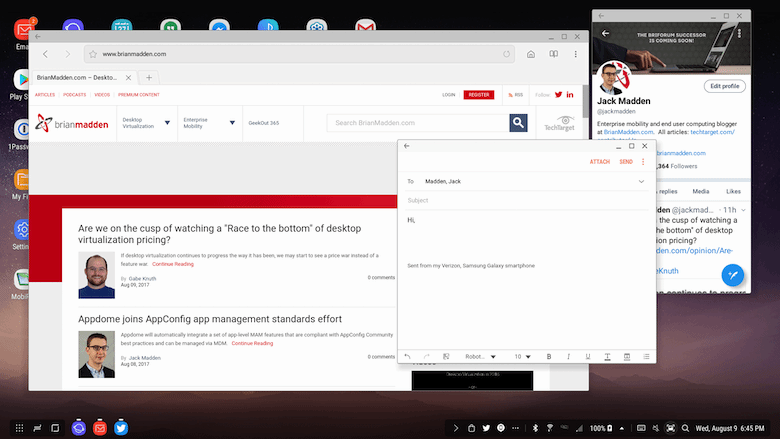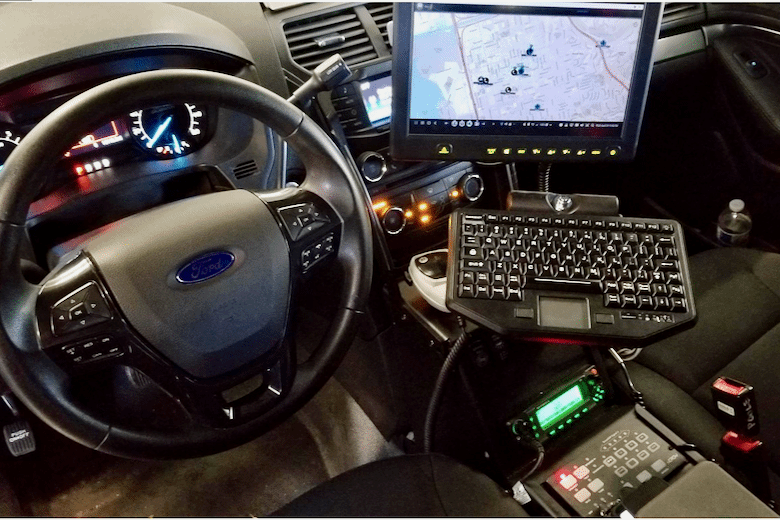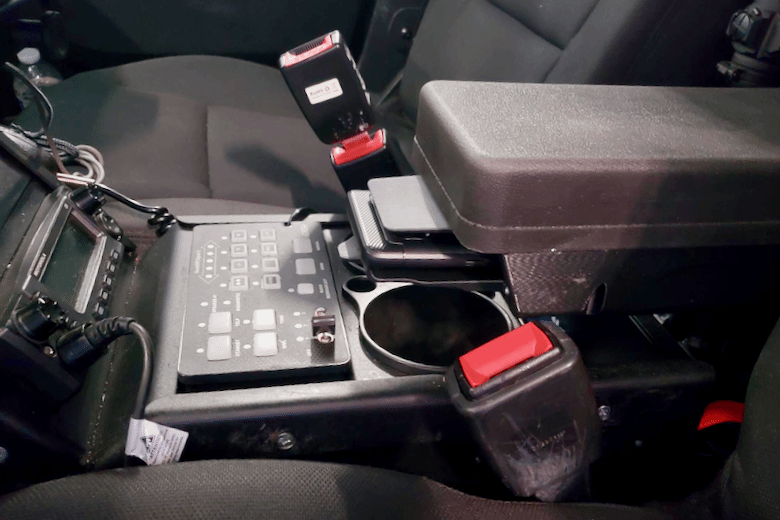I talked to a real-world Samsung DeX pilot customer, the Chula Vista Police Department
It’s taken a while to get here, but DeX is solving a lot of problems for CVPD in one fell swoop. It’s all about having the right use case!
We don’t usually publish formal case studies on BrianMadden.com, but this one is unique. Ever since Samsung launched DeX—their tech for docking a phone and using it like a desktop—I’ve wanted to talk to a real-world customer. Last week, I got to talk to Eric Wood, the police technology manager at the Chula Vista Police Department (CVPD), who is working on a pilot right now.
A quick background on DeX
Samsung is known for experimenting, and they launched their take on what has previously been called the “nirvana phone” concept in 2017. With DeX, you can connect certain Samsung Galaxy phones and tablets to an external display, mouse, and keyboard, and use Android apps in a desktop-like environment, with free-floating windows. There have been several attempts at this concept over the years, but as I wrote after my hands-on review, Samsung was the first company to actually make this work.

The big question is what are the right use cases for DeX. Some people in our industry love experimenting with devices, but personally, I never believed that business professionals who work in typical offices or travel often are going to give up their laptops or tablets anytime soon.
However, I always thought that DeX might be useful for frontline workers who are mostly mobile during the day, but also need a full desktop experience (big screen, mouse, keyboard, etc.) some of the time, in predictable locations and patterns. Most of the people that I’ve talked to at Samsung over the years share this frontline worker vision for DeX as well.
New use cases and devices can take some time to coalesce, especially with frontline scenarios in regulated industries, so I’ve been waiting patiently to speak to a pilot customer. When Samsung reached out with the reference, though, I was pretty excited.
Chula Vista Police Department
Chula Vista is in southern California, near San Diego, with a population of about 270,000 people. The police department has four IT staff members, supporting 400 users, of which 247 are sworn officers. They have about 90 police cars with ruggedized laptops.
Mobility in law enforcement
Before we can get into DeX, we have to look at the current state of mobility in law enforcement.
The Chula Vista Police Department deployed Galaxy S7 smartphones to officers about two years ago, and that actually put them on the leading edge of mobility in law enforcement. Eric told me that when officers transfer in from other departments, they’re pleasantly surprised to get a smartphone.
Law enforcement agencies have been slow to adopt mobility for a few reasons. First, as you could have guessed, it’s just a conservative, regulation-bound industry. Second, they had to wait for MDM and mobile security to mature. Many departments also waited for the introduction of services like FirstNet, a special LTE network that came online two years ago, with all of the traffic prioritization features needed for public safety. And crucially, they had to wait for computer-aided dispatch and records management system software vendors to create mobile clients.
Today, this is all falling into place. Naturally, Samsung sees this as an important new market for their devices and for Knox management and security features.
Like many other industries, mobile devices in law enforcement are replacing some legacy technologies. Previously, the industry standard for mobile computing in police work has been a radio, a notebook, and a ruggedized laptop mounted in a car.
The laptops are very expensive (Eric said $5,300 each for CVPD) and Win32 client apps are also very outdated. It’s hard to get user roaming to work, so all the officers just use generic, non-personalized sessions. (The apps don’t support identities as well as they could, and Eric said they had problems with a bunch of roaming profiles building up in Windows.) Plus, we’re talking about a legacy desktop user interface.
So mobility—before we even get to DeX—brings a lot of benefits. The devices are issued 1:1, so officers are always signed in with their identity, and they can personalize the experience. While previously, officers never really took the laptops out of the cars, mobile devices are—you guessed it—actually mobile, another benefit. The apps have a modern mobile interface, and better features, like using Google Maps instead of whatever was built into their old desktop clients.
Mobile devices are way cheaper, too. At the CVPD, aside from the case, Eric essentially considers the phones to be free, since they get them with carrier promotions and rebates. At first, there was some concern about the ruggedness, but again, they’re so easy to replace and provision that they tell officers not to worry about it. Eric believes that their rugged laptops were way over-spec’d in the first place, and in fact, for their next refresh, they’re going with semi-rugged laptops instead.
One thing that mobile devices haven’t done yet for the CVPD (and most other agencies) is replace traditional radios, as dealing with inter-agency connections is challenging. But overall, people are loving the mobile devices, as you would expect.
Samsung DeX enters the Chula Vista Police Department
Eric said one of the reasons he started a DeX pilot was simply that he’s been interested in the concept for a long time. He’s been at CVPD for four years, but prior to that he worked in the commercial consulting group at Microsoft for 15 years, and was familiar with mobility, desktop virtualization, and Microsoft’s attempt with the nirvana phone concept, Windows Continuum.
When you look at their specific use case, a lot of distinct advantages become apparent real fast.
On the hardware side, with DeX, they can replace $5,300 laptops with a much cheaper screen, keyboard, trackpad, and dock. And remember, the phones are essentially free. In addition, there’s no device in the car to worry about managing and securing anymore.
On the software side, the outdated Win32 client is replaced with a modern one, and the UI is much better suited for being on the road. When you dock a phone in DeX, Android apps are resized to tablet-like versions, and when calls and messages come in, they show up on the big screen.
More importantly, now the user identity and experience is consistent. There are no more generic sessions on a laptop. Instead, officers use the same personalized session in the same client app whether their device is docked or handheld, because it’s all on a single device.
The technology and project scope
Let’s take a closer look at what’s going into this pilot.
On the software side, the CVPD already had mobile clients. Eric said that these licenses are expensive (but clearly they’re worth it). They did have to work with their software vendors to make sure their apps handled DeX well. Basically, when the device is docked or undocked and the app is resized, vendors need to make sure that the session state is preserved, instead of completely relaunching and possibly requiring a new sign in. But this isn’t too hard, and he said that his vendors have been responsive. Today, Eric is giving pilot users access to their desktops back in the police station in case they need to access any Windows apps. In production, the plan would be to set up a full desktop virtualization environment.
On the hardware side, CVPD purchased Galaxy Note9 phones, along with displays, keyboards, and touchpads. Their mounting provider, Gamber-Johnson, is providing the mounting, the dock, and a 3-D-printed cradle free of charge as part of the pilot; and their local installer is providing some free services as well.


The pilot started in January and runs through the end of the year, when they’ll decide whether to go into production. Right now, it involves three officers who are in more proactive roles, which means instead of responding to 911 calls, they’re out doing community policing, going to schools, and generally doing things that are more tolerant of any technical rough edges. CVPD has outfitted two cars, with clearance for two more.
Eric is definitely optimistic about the project. He said that the response has been positive, and that the pilot could expand a little faster, possibly to eight cars.
The main issue he described was that, today, most officers travel with their phones on their belt or vest. So if it’s docked in the car, they have to remember to undock it and take it with them. This could be a problem if they do a emergency stop and they don’t have the muscle memory to grab the phone as they exit the car. But as an alternative, Eric likes the idea of outfitting officers with GPS and cellular-enabled smart watches. Samsung has been working on smart watches for business use cases, so this should be feasible.
Another idea Eric wants to look at down the road is providing laptop-style docks, for when officers are taking notes outside of their car. Samsung hasn’t gone down this road yet, but there are other options out there.
Conclusions
To me, this sounds like a quite compelling use case, and I’m glad to finally meet a pilot customer.
For any DeX use case, you have to do a gut check and ask if the needs could be better served with two devices. In this case, it all comes down to the software.
Currently, the legacy desktop clients for law enforcement software clearly don’t serve user needs. In theory, the clients could be modernized. The vendors could update update the UI, and add in modern identity management and session management features. But that’s a ton of work to put in to a legacy Windows client, and it’s hard to do well. Officers would be frequently switching back and forth from the mobile client to the desktop client. How many apps do a really good job of handling identities, session states, and syncing data that quickly? Not many. If you’re switching clients often (possibly in an emergency situation), you can’t be waiting for an app to sync. Also web apps aren’t a good fit, since law enforce software needs access to full GPS hardware.
So instead of waiting around and hoping that the software gets better and that it works perfectly, it makes a lot more sense just to use a single device. The software vendors have already invested in mobile clients, so the apps are there and the experience is modernized. Since it’s a single device, you don’t have to worry about syncing or roaming sessions. You know that the officers are always going to have a dock where they need it (in the car, in the station, or even a laptop version). Simply put, this is a way for the customer to take things into their own hands.
Experimenting is hard and doesn’t always go smoothly, but Samsung has continued to put a lot of work into DeX over two years. There are other law enforcement DeX pilots in progress, too.
Eric said that he likes Samsung’s work on DeX, and he hopes it continues. I think it should, too. Again, I found this use case to be captivating, and I’m looking forward to checking in with CVPD and other customers get further down the line.







